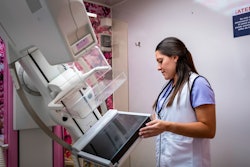A new cancer screening service model developed by Italian researchers can reduce direct non-medical costs and improve environmental sustainability for breast cancer screening and other screening exams.
The investigators, led by doctoral candidate Vera Benedetto from the Health Science Interdisciplinary Center in Pisa, found that their model, which utilizes mobile cancer screening for breast, cervical, and colorectal cancer, reduced costs by over 95,000 euros ($101,155 U.S.) in terms of travel costs and productivity losses. It also reduced as much as 35 tons of carbon dioxide (CO2)-equivalent travel emissions for a population of 59,000 Tuscan inhabitants with around 6,000 people involved in a screening program.
“The study supports the need to adopt a new planning methodology that considers environmental, social, and financial sustainability jointly in the provision of public health services in rural areas,” Benedetto and colleagues wrote.
Sustainability has become an area of exploration for radiology practices to explore. Previous reports indicate that actions such as powering down CT and MRI machines when not in use or setting idle time aside for machines can decrease energy use and costs. However, the researchers pointed out that health planning “still lacks an integrative view about environmental and social sustainability goals.”
The team proposed its methodological approach with the goal of ensuring coherence between health, environmental, and social goals in planning.
Among the services provided, a mobile screening unit equipped with a team of health professionals, including radiology technicians and obstetricians, can perform tests and collect health screening data close to the home of invitees. From there, screening data from mammograms and other exams are systematically transferred from the mobile unit to local health authority facilities.
This delivery model relies on areas and assets shared by the local community, such as the parking spot of the mobile unit, electricity needed to deliver services, and communication and local sensitization campaigns to promote participation.
“With the new service provision, there are no changes in the composition of the health team compared to the current screening program,” the authors wrote.
The researchers also performed a cost analysis to estimate the difference in CO2 equivalent emissions, travel costs, and productivity losses. They compared the current screening programs against the introduction of their comprehensive full-service mobile screening unit.
The service model would decrease the total environmental impact by about 98%, employing 0.8 tons of CO2-equivalent to deliver all required screening services to all invitees of the Valle del Serchio district annually. Additionally, the team reported that the new model would decrease total direct non-health costs, owing to the mobile unit reducing the travel time of invitees.
| Comparison between conventional, mobile screening models (U.S. dollars in parentheses) | |||
|---|---|---|---|
| Year 2020 | Conventional screening model | Mobile screening model | Annual differential costs |
| Travel expense for mobile unit | 0 euros ($0) | 2,152.84 euros ($2,296.83) | 2,152.84 euros ($2,296.83) |
| Total transportation and working days dedicated by the community for screening visit costs | 168,032.69 euros ($179,271.56) | 70,288.40 euros ($74,989.64) | -97,744.29 euros (-$104,281.92) |
| Total nonmedical costs | 168,032.69 euros ($179,271.56) | 72,441.24 euros ($77,286.47) | -95,591.45 euros (-$101,985.08) |
| Total emissions traveled linked to the cancer-screening programs -- women (kgCO2-eq/km) | 31,721.12 | 656.38 | -31,428.72 |
| Total emissions traveled linked to the cancer-screening programs -- men (kgCO2-eq/km) | 3,785.25 | 148.18 | -3,637.06 |
| Total environmental costs (kgCO2-eq/km) | 35,870.36 | 804.57 | -35,065.79 |
The study authors highlighted that their results show how health systems should consider a shift in planning public health services by considering the environmental and social impact of services delivered. They added that to increase sustainability, advanced planning, and organizational approaches are needed to assess financial burdens and environmental impact on preventive health services.
“From October 2023, the new screening program delivery model illustrated in this paper will be carried out within the above-described geographical area,” the authors wrote. “Thus, it is important now to investigate if attendance to screenings will increase as expected by means of this implementation.”
They concluded that their study is a first step toward including support measures for environmental and social sustainability within the planning process of healthcare services that can be proposed at local, regional, and national levels.
The full study can be found here.



















